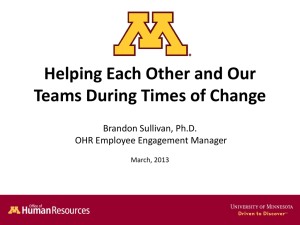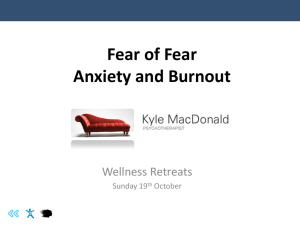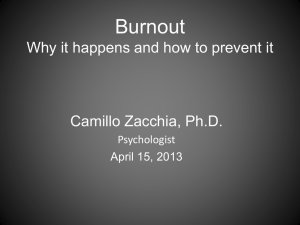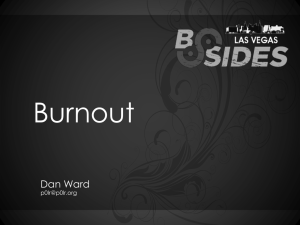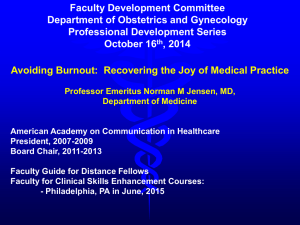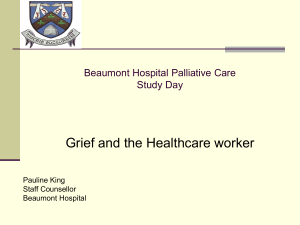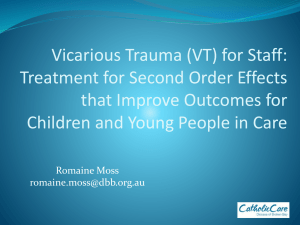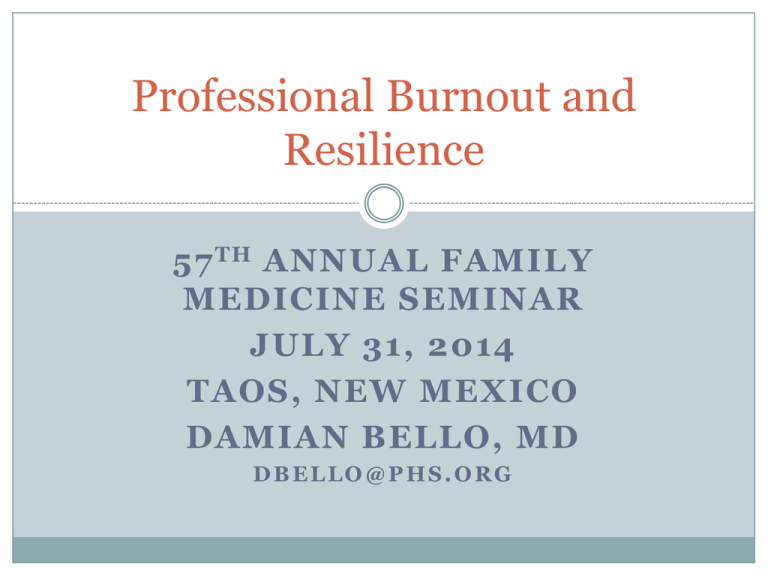
Professional Burnout and
Resilience
57 TH ANNUAL FAMILY
MEDICINE SEMINAR
JULY 31, 2014
TAOS, NEW MEXICO
DAMIAN BELLO, MD
DBELLO@PHS.ORG
Professional Burnout and
Resilience
MAINTAINING
HUMANITY, COMPASSION,
AND EXCELLENCE
IN AN EVER MORE
CHALLENGING
PRACTICE ENVIRONMENT.
I feel emotionally drained from
my work
Yes
No
Sometimes
I’ve become more callous towards
people since I took this job
I feel I’m positively influencing
other people’s lives through my
work
Goals/Organization of talk
Define Burnout
Describe how it effects providers and patients
Understand how burnout occurs
Discuss how burnout is assessed
Discuss ways to prevent burnout and treat it.
II. What is Burnout and
How Does it Occur?
Definition - Historical Perspective
Merriam-Webster, “Burnout is the condition of
someone who has become physically and
emotionally tired after doing a difficult job for a
long time”
1974 – Freudenberger, “The extinction of
motivation or incentive, especially where one's
devotion to a cause or relationship fails to produce
the desired results.”1
1981 – Maslach & Jackson, Maslach Burnout
Inventory
1Fraudenberger
H. Burnout: The High Cost of High
Achievement - 1974
Professional Burnout Definition1
1.
Emotional Exhaustion - A chronic state of
physical and emotional fatigue resulting from
excessive professional and personal demands .
2. Depersonalization – A set of callous and
insensitive behaviors toward or feelings about one’s
patients, coworkers or even oneself .
3. Ineffectiveness - Decreased sense of personal
accomplishment.
1Maslach,
C., Jackson, S. E., & Leiter, M. P. (1996). The Maslach Burnout Inventory (MBI). Third edition,
Consulting Psychologists Press
How big is the problem?
Half of all physicians report at least 1 symptom of
burnout1 and ⅓ – ½ of physicians meet burnout
criteria2
½ of medical students have symptoms of burnout
The rate of burnout is increasing. 63% report more
burned out than three years ago3
1. Shanafelt, Arch Intern Med. 2012;172(18):1377-1385.
2. Dyrbye, JAMA. 2010;304(11):1173-1180. doi:10.1001/jama.2010.1318.
3. 2011 Cvejka survey
Symptoms of Burnout
Emotional Exhaustion
Depersonalization
Inefficacy
Loss of enthusiasm for
work
Cynicism/Sarcasm
Low sense of
accomplishment
Dread going to work
Feeling like the patient is
the problem
Feeling unproductive
Hard to get work day
started
Getting angry with
patients
Loss of job satisfaction
Fatigue
Irritability and moodiness Worries about getting
with co-workers & staff
fired or disciplined
Desire to work less, retire
early, or change careers
Results of burnout/Signs of Burnout
Emotional Exhaustion
Depersonalization
Inefficacy1
Decreased hours of work
Decreased patient
satisfaction/experience
Decreased job
performance
Early retirement or
resignation
Increased patient
complaints
Lower quality of work
Poor physical and mental
health
Increased medical errors
Decreased productivity
Lower Primary
Care Workforce
Lower Medicare
Reimbursement
Lower Quality*
1Shanafelt,
Dyrbye
American Family Physician 2013
Results of Burnout
67% of physicians would leave medicine
today if they could4
2/3 of Family Physicians would choose
medicine again, but only 1/3 would
choose family medicine5
1. Advisory Board
2.Medscape Physician Comp Report
2014
CGCAHPS
The Clinician and Group Consumer Assessment of
Healthcare Providers and Systems
Measures patient experience
For large medical groups, reimbursement tied to
high scores (9-10)
Examples
During your most recent visit, did this provider listen carefully
to you?
During your most recent visit, did this provider seem to know
the important information about your medical history?
During your most recent visit, did this provider spend enough
time with you?
Physician Wellness and Quality
Reduced workplace productivity and efficiency
Increased probability of ordering unnecessary tests
and procedures
Burnout increased physicians self reported poor
quality of care
Physician job satisfaction effects patient adherence
to treatment
Burned out residents are 2-3x more likely to report
giving suboptimum care
1Wallace, Physician Wellness: a missing quality
Characteristics of Burnout
Occurs more frequently than admitted both by
employers of physicians and by physicians
themselves
Frequently ignored or accepted as part of doing
business
There is an overriding rationalization of and
resistance to seeking and accepting help
More Characteristics
Occurs on a continuum
Not related to how hard or how much we are
working
Tends to Occur in phases
Women and men experience burnout differently
Response to stress – sex differences
Men
Women
Emotional Exhaustion
Depersonalization
Depersonalization
Emotional Exhaustion
Lack of efficacy
No sense of lack of
efficacy
How does Burnout Occur?
Stress
Stress
Stress
Burnout
Stress is normal, Burnout is not.
How
Burnout
Happens
Drummond – thehappymd.com
Burnout and Engagement
Burnout versus Engagement
Exhaustion
Energy
Depersonalization
Involvement
Inefficacy
Efficacy
“BURNGAGEMENT”
Burnout and Depression - Not the Same
Depression
Burnout
Effects are at work
Fatigue
Loss of job satisfaction
Feeling unproductive
Unable to get on top of
workload
6. Irritable with coworkers and patients
7. Hard to get work day
started
1.
2.
3.
4.
5.
1.
2.
3.
4.
5.
6.
7.
Effects all aspects of
life
Fatigue
Anhedonia
Low self esteem
Poor concentration and
memory at work and
home
Irritable with everyone
Hard to get anything
started
III. Causes and Risk Factors
The Perfect Storm
Professions with High Stress/Burnout
Education
Social Work
Real Estate
Health Professions
Job Stressors in High Burnout Professions
Air- traffic
controller
Life or
death
consequen
ces
x
Emotionally
charged
participants
Ethical
dilemmas
Physically
dependent
charges
Expectation
for
perfection
Hostage
negotiator
x
x
x
Judge
x
x
Motherhood
newborn
x
x
x
Healthcare
professional
x
x
x
x
x
High Burnout in Family Medicine1
1Shanafelt
Forms of stress
Physical
Emotional
Spiritual/Dissatisfiers
Physical Stressors
Sheer amount of work1
Extremes of activity2
Poor self care - Lack of sleep3,4
Demands outside work
Illness or poor health
1Kimberly - Am J Public Health. 2003 April; 93(4)
2MayoClinic.org
3Miller - South Med J. 2000;93(10)
4Lancet 2009- Wallace
Emotional Stressors
Constant expectation to empathize
Helping people in crises is part of the job
Social or geographic isolation
Spiritual Stressors
Things that cause us to question
what we are doing and why. “Crisis
of Meaning”
Inability to reconcile what we are
doing with what we want to do.
Self Determination Theory1
Competence
The need to feel valued as knowledgeable and skilled
To experience mastery
Relatedness
The need to collaborate with colleagues and co-workers
The need to interact, be connected to, and experience caring
for others
Autonomy
The need to exercise some control/influence to achieve
practice goals
Sense of contribution to goal.
1Deci,
E., & Ryan, R. (1991). Nebraska symposium on motivation:
Vol. 38. Perspectives on motivation (pp. 237–288).
AMA Study1
656 physicians, 30 practices, six states
January 2013 through August 2013
Key questions:
What factors influence physician professional satisfaction
What are the implications of these factors for patient care,
health systems, and health policy?
Four Key findings
Importance of delivering high-quality healthcare
Pros and cons of electronic health records
Value of stability and fairness
Cumulative burden of regulations
1Friedberg - Factors Affecting Physician Professional Satisfaction and Their Implications for Patient Care, Health Systems, and Health Policy. Santa
Monica, CA: RAND Corporation, 2013. http://www.rand.org/pubs/research_reports/RR439
EMR
The
Electronic
Medical
Record
Positives
Legibility
Prescribing ease
Information Sharing
Negatives
Physical stress: Increased work
Emotional stress: Barrier to Empathy
Spiritual stress:
Often does not improve the clarity of
documentation for clinical purposes
Sacrifices documenting to improve
patient care for coding and billing
The doctor patient relationship
Changing with the times
Pressure to see more patients
Effected by remodeling of the health care system
EMR
Affected negatively by increased rates of burnout
Patient satisfaction tied to reimbursement
How important is it?
Mixed Messages/Competing Demands
Produce v. Take care of all pts needs
today
See patients v. Participate in
meetings
Produce v. Improve quality
Document well v. Document fast
Managing Multiple Expectations
Patients
Industry
Ourselves
The medical profession
Our practice/employers
Cultural
Our families
Risk Factors for Burnout
Incurs higher risk
Age <35
Middle stage of practice, 10-20 yrs post residency
Female > Male
Specialty, front lines of medicine
Adequate savings
Social or geographic isolation
Poor physical and mental health
Certain personality traits
No risk association
Religious involvement was protective1 or not correlated2
Political Leanings2
Personality as a Risk Factor
Personality Characteristics – innate, hard to change
Hardiness
Humility
Perfectionism
Introversion/extroversion
Workaholism
Type A
Compulsiveness
Optimism/pessimism
Behaviors and preconceptions – acquired, easier to change
Charting habits
Taking on too much v saying “no”
Staying late v setting limits
Poor self care
Reluctance to take time off
Attitude and demeanor
Values and their corruption1
1BO
and Resilience FPM article
IV. Assessing Burnout
Why is burnout so hard to address?
For Providers - Culture of Medicine
Culture of Silence
Pressure to appear well as a sign of competence
Ethical dilemmas: collegial privacy v pt safety
Pluralistic Ignorance: A situation in which a majority of group members
privately reject a norm, but incorrectly assume that most others accept it,
and therefore go along with it.
For Organizations
Lack of perceived value
Fear
1.
Burnout
I feel emotionally drained from
my work (Emotional
Exhaustion)
2. I’ve become more callous
towards people since I took this
job (Depersonalization)
3. I feel I’m positively influencing
other people’s lives through my
work (Personal
Accomplishment/Efficacy)
Maslach Burnout Inventory1
MBI - 22 total questions
9 on Emotional exhaustion - high is worse,
5 on Depersonalization – high is worse
8 on Personal Accomplishment – high is better
Scores are divided into high, moderate, and low
aMBI - Abbreviated Maslach Inventory2
9 questions – 3 in each area
3 additional questions on “Satisfaction with Medicine”
1http://www.mindgarden.com/products/mbi.htm
2McManus
2003, British Medical Journal, 327, 139-142)
aMBI
abbreviated
Maslach
Burnout
Inventory
http://www.aagbi.org/sites/default/files/Maslach%20ScoringAbbreviated.pdf
Compassion Fatigue Assessment1,2
Invisible Signs
Visible Signs
Marked decline in work efficiency?
Intent on clinical tasks to the detriment
of patient interactions?
More callous toward patients than in
the past?
Signs of mental or physical breakdown
during crisis periods?
Outbursts of anger or irritability with
little provocation?
Declining opinion of caregiver role?
Treats patients like impersonal
objects?”
Developed a pressing desire to explore
an entirely different profession?
Repeatedly fails to fulfill clinical
responsibilities?
1.
2.
3.
4.
5.
6.
7.
8.
9.
1The
10.
11.
12.
13.
14.
15.
16.
17.
18.
Reduced sense of accomplishment
Harbor a secret happiness when a
procedure is cancelled?
Avoid interactions with patients and
colleagues when possible?
Often leave work feeling ineffective in
job?
Mood swings with every patient
interaction?
Resentment about role as caregiver?
Unhealthy attachment to patients?
Poor patient outcomes adversely affect
continued performance?
Anxiety when interacting with
emotional patients?
Advisory Board Company, Washington, DC
http://www.advisory.com/Talent-Development/Leader-Development/Members/Workshop-Resources/Operations/Hardwiring-Service-Excellence
2Pfifferling J, Overcoming Compassion Fatigue, Fam Pract Manag. 2000 Apr;7(4):39-44.
Informal Surveys
Background
The PMG Engagement Subcommittee - with input from
Lead Physicians - put together a one page survey, sent out
to all providers during the month of December, 2013.
Questions – 5 point scale
Does your work schedule allow you to maintain
appropriate work/life balance?
Are the following staff in your clinic effective and helpful?
Do you find yourself working past scheduled hours
Results
Informal Self-Assessment1
Have you become cynical or critical at work?
Do you drag yourself to work and have trouble getting started
once you arrive?
Have you become irritable or impatient with coworkers,
customers or clients?
Do you lack the energy to be consistently productive?
Do you lack satisfaction from your achievements?
Do you feel disillusioned about your job?
Are you using food, drugs, or alcohol to feel better or just
simply not feel?
Have your sleep habits or appetite changed?
Are you troubled by unexplained headaches or other physical
complaints?
1Job
burnout: how to spot it and take action, Mayo Clinic.org
www.mayoclinic.org/healthy-living/adult-health/in/depth/burnout
The Burnout Continuum
Engagement
At Risk
Some
Burnout
Full
Burnout
V.
Treatment/Prevention/Resilien
ce
Who’s responsible?
Individual Providers
Organizations
Medical schools
Medical profession
Government and policy makers
Healthcare Industry
Happiness Research Analogy
50% predetermined by genetics and family
50% changeable
10-38%
determined by recent event
12-40%
under individual control
Lykken, Psychological Science Vol.7, No. 3, May 1996
Dual Responsibility
Individual
Organizational
The Burnout Continuum
Engagement
Some
Burnout
Full
Burnout
Where to Start?
Engaged
Some burnout
Full burnout
✓
Treat burnout
Decrease stress
✓
✓
Increase
resilience
✓
✓
Treating Burnout
Take an Intentional Break*
Take time to reflect on what is important to you
Recall your personal values and why you went into
medicine
Commit to 1-2 doable changes when you get back
Interventions that have been shown to help
Participation in a discussion group
Practicing mindfulness
*supported
by evidence
Benefits of Meditation
Better Focus
Less Anxiety1
More Creativity
Fosters Compassion1
Better Memory
Less Stress1
More Grey Matter
1Ann
Fam Med September/October 2013 vol. 11 no. 5 412-420
What is this “Mindfulness”?
A quality of the mind cultivated by meditating
where you train yourself to notice your
thoughts without judging them.
“Mindfulness means paying attention in a
particular way, on purpose, in the present
moment, and non-judgmentally.”
-Jon Kabat-Zinn
MBSR (Mindfulness Based Stress Reduction)
Strategies for Burnout
Downtime, rest, and rejuvenation
Improve personal health
Creative CME – audioCME, Smartbriefs
Work-Life balance, strengthen self-identity
Ask yourself pointed questions
Increase personal efficacy
Try to acknowledge staff and connect with colleagues every day
Get to know something personal about your patients
Gaining insight and self-reflection
Decrease workload, increase efficiency
Change your routine**
Improve relatedness/decrease isolation and depersonalization
Recommit to personal wellness
Stress reduction and increasing energy
Take a few 5-10 minute breaks throughout your day
Carve out time for friends and family
Increase autonomy, control
Reset the expectations of your patients
Change Your Routine
Still Stuck?
Strategies List
Resource List
Organizational Strategies
Incorporate provider wellbeing into
organizational values and structure
Prevention strategies should be:
Thoughtful
Practical
Well-supported
in the organization
Provider Wellness Models
Passive
Open door policy
Focusing on positive
Reactive
Critical incident stress debrief
Suggesting outside counsel
Proactive
Well-being assessment
Thoughtful, practical and supported prevention strategies
Organizational Strategies
Promote Resiliency
Autonomy -
Relatedness –
Competence –
Decrease Stress
Physical –
Emotional -
Spiritual –
Organizational Strategies
Promote Resiliency
Autonomy - promote a culture of transparency and fairness
Relatedness –
Competence –
Decrease Stress
Physical –
Emotional -
Spiritual –
Organizational Strategies
Promote Resiliency
Autonomy - promote a culture of transparency and fairness
Relatedness – promote peer-peer interaction
Competence –
Decrease Stress
Physical –
Emotional -
Spiritual –
Organizational Strategies
Promote Resiliency
Autonomy - promote a culture of transparency and fairness
Relatedness – promote peer-peer interaction
Competence – improve support of CME (time and money)
Decrease Stress
Physical –
Emotional -
Spiritual –
Organizational Strategies
Promote Resiliency
Autonomy - promote a culture of transparency and fairness
Relatedness – promote peer-peer interaction
Competence – improve support of CME (time and money)
Decrease Stress
Physical – decrease burden of regulations
Emotional -
Spiritual –
Organizational Strategies
Promote Resiliency
Autonomy - promote a culture of transparency and fairness
Relatedness – promote peer-peer interaction
Competence – improve support of CME (time and money)
Decrease Stress
Physical – decrease burden of regulations
Emotional - offer coaching or mindfulness courses
Spiritual –
Organizational Strategies
Promote Resiliency
Autonomy - promote a culture of transparency and fairness
Relatedness – promote peer-peer interaction
Competence – improve support of CME (time and money)
Decrease Stress
Physical – decrease burden of regulations
Emotional - offer coaching or mindfulness courses
Spiritual – Support Discussion Groups
Types of Discussion Groups
Informal, unstructured groups
Peer facilitated discussion groups
Balint Groups
Schwartz Center Rounds
Schwartz Center Rounds
Demonstrated best practice
Combats provider burnout and improves service
simultaneously
Structure and design elements
Modeled after M&M rounds
Based on case presentations
Presentations proud discussions of underlying issues
Staff share best practices to address issues
Guided by a facilitator
Support Forums/Schwartz Center Rounds
Key Attributes
Structured, regular forum for peer-to-peer support
Opportunity to work together on difficult interactions
Provision of framework to think through difficult patient situations
Opportunity to learn from others about how to manage stressors
Open discussion of emotions to help manage stress
Common Pitfalls
Discussion times fall to the wayside overshadowed by other priorities
Culture prohibits sharing concerns
Devolves into a complaining session
No demonstrated learning change or alleviation of stress
Schwartz Center Rounds
Supported by the Schwartz Center founded by Ken
Schwartz before he died of lung cancer in 1995
Nearly 300 hospitals and medical centers hold the
rounds
Open to all professionals with patient care
responsibilities
Help monthly 430 to 150 caregivers at no cost to the
hospital
Rounds first piloted at Mass General Hospital in
1997
Schwartz Center Video
The Schwartz Center Story
http://bcove.me/y5irjltl
More Research is Needed
Further research is needed to explore how
interventions designed to improve provider wellness
are also beneficial to patients and the organizations
VI. Conclude and Closing
Thoughts
CALVIN AND HOBBES FEEDING DAD THE BUG
Questions
and
Comments

